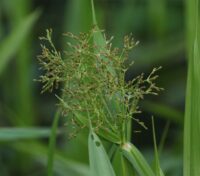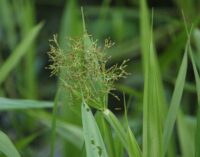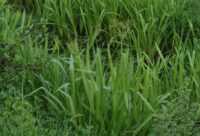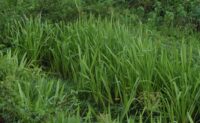Rhynchospora corymbosa (L.) Britton, Trans. New York Acad. Sci. 11: 84 (1892) (syn: Calyptrostylis articulata (Roxb.) Nees ; Calyptrostylis asperula var. minor Nees ; Calyptrostylis divergens Nees ; Calyptrostylis fascicularis Nees ; Calyptrostylis florida (Rudge) Nees ; Calyptrostylis gaudichaudii Nees ; Calyptrostylis rudgei Nees ; Cephaloschoenus articulatus (Roxb.) Nees ; Cephaloschoenus divergens Nees ; Chaetospora aurea Kunth ; Dichromena corymbosa (L.) J.F.Macbr.; Rhynchospora articulata (Roxb.) Schult. ; Rhynchospora aurea Vahl ; Rhynchospora aurea f. florida (Rudge) Lindm. ; Rhynchospora corymbifera Nees ; Rhynchospora corymbosa var. angustirostris (Barros) Guagl. ; Rhynchospora corymbosa f. angustirostris Barros ; Rhynchospora corymbosa var. bonariensis Barros ex Cabrera & Dawson ; Rhynchospora corymbosa var. chacoensis (M.Barros) Svenson ; Rhynchospora corymbosa f. chacoensis M.Barros ; Rhynchospora corymbosa var. florida (Rudge) Kük. ; Rhynchospora corymbosa var. grandispiculosa Kük. ; Rhynchospora corymbosa var. minor (Nees) Kük. ; Rhynchospora corymbosa var. singularis Kük. ; Rhynchospora florida (Rudge) Schult. ; Rhynchospora florida var. nigra Griseb. ; Rhynchospora grandifolia Boeckeler ; Rhynchospora macrocarpa Boeckeler ; Rhynchospora puncticulata var. pleiocephala Osten ; Rhynchospora schraderiana Steud. ; Rhynchospora sclerioides f. saxicola (F.Br.) Kük. ; Rhynchospora sclerioides var. stokesii (F.Br.) Kük. ; Rhynchospora spectabilis Hochst. ex C.Krauss ; Rhynchospora stokesii F.Br. ; Rhynchospora stokesii f. saxicola F.Br. ; Rhynchospora subulirostris Steud. ; Rhynchospora surinamensis (Rottb.) Nees ; Schoenus articulatus Roxb. ; Schoenus corymbosus (L.) Pers.; Schoenus floridus Rudge ; Schoenus surinamensis Rottb. ; Scirpus bangalorensis B.Heyne ex Wall. ; Scirpus corymbosus L.; Scirpus umbellatus Roxb. ex Kunth);
.
Tropics & Subtropics: Andaman Is., Angola, Argentina Northeast, Argentina Northwest, Argentina South, Assam, Bangladesh, Belize, Benin, Bismarck Archipelago, Bolivia, Borneo, Botswana, Brazil North, Brazil Northeast, Brazil South, Brazil Southeast, Brazil West-Central, Burkina, Burundi, Cambodia, Cameroon, Cape Provinces, Caroline Is., Central African Repu, Chad, China South-Central, China Southeast, Colombia, Congo, Costa Rica, Cuba, Dominican Republic, East Himalaya, Ecuador, Equatorial Guinea, Ethiopia, Fiji, French Guiana, Gabon, Galápagos, Gambia, Ghana, Guatemala, Guinea, Guinea-Bissau, Gulf of Guinea Is., Guyana, Hainan, Honduras, India, Ivory Coast, Jamaica, Jawa, KwaZulu-Natal, Leeward Is., Lesser Sunda Is., Liberia, Madagascar, Malawi, Malaya, Mali, Maluku, Marianas, Mauritania, Mauritius, Mexico Central, Mexico Gulf, Mexico Southeast, Mexico Southwest, Mozambique, Myanmar, Nansei-shoto, New Guinea, New South Wales, Nicaragua, Nicobar Is., Nigeria, Northern Territory, Panamá, Paraguay, Peru, Philippines, Puerto Rico, Queensland, Samoa, Senegal, Sierra Leone, Society Is., Sri Lanka, Sudan, Sulawesi, Sumatera, Suriname, Taiwan, Tanzania, Thailand, Togo, Tonga, Trinidad-Tobago, Tubuai Is., Uganda, Uruguay, Vanuatu, Venezuela, Vietnam, Wallis-Futuna Is., Windward Is., Zambia, Zaïre, Zimbabwe as per POWO;
.
Erect, tufted, rhizomatous perennial herbs; rhizome short, thick, withut stolons; culms triquetrous, 70-120 cm tall, several-nodose. Leaves basal and cauline, many, 35-80 x 1-2 cm, linear, flat, margins scabrid, apex long-acuminate, keeled, thinly coriaceous; sheaths to 10 cm long. Panicles corymbose, terminal, 15-30 cm long; rays c. 10, upto 10 cm long; leafy bracts 10-28 cm long. Spikelets 6-10 x 1-2 mm, lanceolate, subterete, acute, chestnut-brown, 2-3-flowered, lowest flower bisexual, upper one male. Glumes 5-7, subdistichous; lower ones smaller, ovate, upper ones 3-5 x 1.5-2 mm, oblong-ovate, light brown. Hypogynous bristles 6, in bisexual flowers and 1-3 in male flowers. Stamens 3. Style-baseconical, compressed, grooved on both sides. Nuts 2-3 x 1.5-2 mm, oblong-obovate, irregularly rugose, brown.
Flowering and fruiting: August-January
Wet grasslands, open marshes
(Attributions: Dr. N Sasidharan (Dr. B P Pal Fellow), Kerala Forest Research Institute, Peechi as per India Biodiversity Portal)
.




Cyperus sp. from Assam KD 09 Aug 22:
Attached images are Cyperus sp, from Assam. Please Id of the sp.
Date : 29.08.22
Location: Assam
Family : Cyperaceae
Genus & species : Cyperus ?
Habit : Herb
This does not appear to be cyperus. Maybe some other genus.
May be. Thank You Sir.
Looks like Rhynchospora corymbosa of Cyperaceae
Does it not look different from Rhynchospora corymbosa as per images at ?:
https://portal.wiktrop.org/species/show/638
http://www.efloras.org/object_page.aspx?object_id=122089&flora_id=2
https://powo.science.kew.org/taxon/urn:lsid:ipni.org:names:220271-2
https://www.gbif.org/species/2721495
https://www.researchgate.net/figure/Rhynchospora-corymbosa
Can it be some Actinoscirpus species like Actinoscirpus grossus (L.f.) Goetgh. & D.A.Simpson?
The Rhynchospora images in each of the above links looks different and hence is confusing.
Yet, I would suggest to get it verified from an expert on Cyperaceae.
A feedback from another post:
Could this be Scirpus sylvaticus the wood clubrush, the pictures are similar.
I am no Cyperus expert, just that the Genus has many Aquatic Cyperus, some of which are even sold in Aquarium trade Cyperus helferi, (seems to be a new craze in Mumbai Aquarium shops) and many like Scirpus mucronatus, use knife like Leaves to puncture water lilies, Schonoplectella articulata are ghost like and strange.
Another possibility is Woodland Bulrush (Scirpus expansus) photo attached
Both these species do not have distribution in our area as per POWO 1 and POWO 2
.
References:
POWO Catalogue of Life India Flora Online India Biodiversity Portal Wikipedia Plant net
